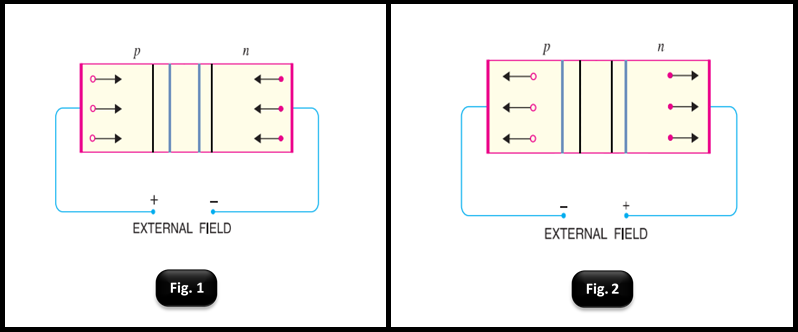Explain forward and reverse bias conditions in PN junction diode.
Forward biasing: When the external voltage applied to the junction is in such a direction that it cancels the potential barrier, thus permitting current flow, the junction is said to be in forward biased condition.
- To apply forward bias, connect positive terminal of the battery to p-type and negative terminal to n-type as shown in fig. 1.
- The applied forward potential establishes an electric field which acts against the field due to potential barrier. Therefore, the resultant field is weakened and the barrier height is reduced at the junction as shown in fig. 1. Therefore, the resultant field is weakened and the barrier height is reduced at the junction.
- As potential barrier voltage is very small (0.1 to 0.3 V), therefore, a small forward voltage is sufficient to completely eliminate the barrier.
- Once the potential barrier is eliminated by the forward voltage, junction resistance becomes almost zero and a low resistance path is established for the entire circuit. Therefore, current flows in the circuit. This is called forward current.
With forward bias to p-n junction, the following points are worth noting:
- The potential barrier is reduced and at some forward voltage (0.1 to 0.3 V), it is eliminated altogether.
- The junction offers low resistance (called forward resistance, Rf) to current flow.
- Current flows in the circuit due to the establishment of low resistance path. The magnitude of current depends upon the applied forward voltage.
Reverse biasing: When the external voltage applied to the junction is in such a direction that potential barrier is increased, this set-up is said to be in reverse biased condition.
- To apply reverse bias, connect negative terminal of the battery to p-type and positive terminal to n-type as shown in fig. 2.
- It is clear that applied reverse voltage establishes an electric field which acts in the same direction as the field due to potential barrier. Therefore, the resultant field at the junction is strengthened and the barrier height is increased as shown in fig. 2.
- The increased potential barrier prevents the flow of charge carriers across the junction. Thus, a high resistance path is established for the entire circuit and hence the current does not flow.
With reverse bias to p-n junction, the following points are worth noting:
- The potential barrier is increased.
- The junction offers very high resistance (called reverse resistance, Rr) to current flow.
- No current flows in the circuit due to the establishment of high resistance path.
